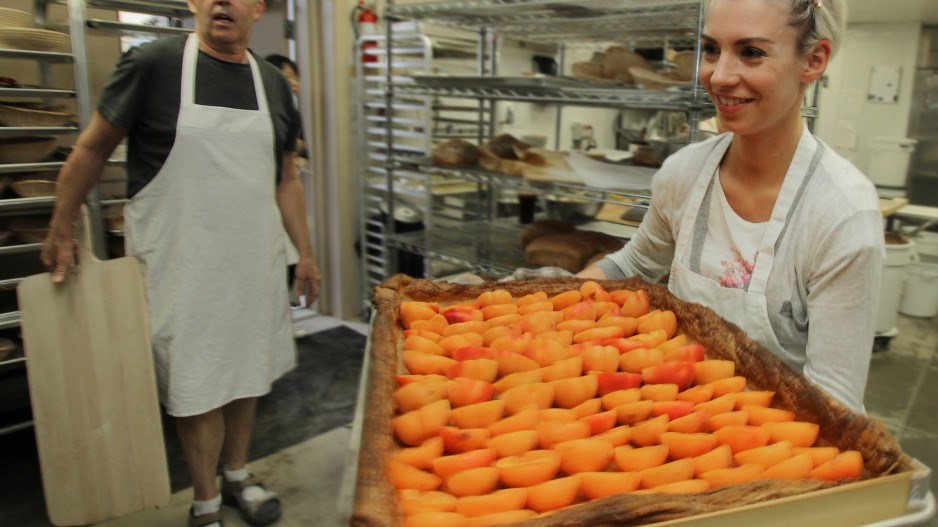Elsie Born and her parents wanted to open their bakery somewhere fun, not too crowded, “where kids could meet grandma for lunch.”
They found the perfect place along a pedestrian strip of Fraser Street that’s quickly becoming a home for new small businesses. Earnest Ice Cream found its success there in 2013, and other restaurants and coffee shops have moved in since. The area between 31st Avenue and Kingsway has even been given a new name by locals: Fraserhood.
The Borns bought a 1912 building on Fraser between King Edward and 24th Avenue. After a year of renovations, they openedBâtard Boulangerie and Café Moderne with a partner in early 2015.
“Main Street is overpopulated and hard to be noticed,” said Born. “Here, it’s exciting and evolving all the time.”
Fraserhood isn’t the only Vancouver pedestrian area that’s been rechristened due to changing business demographics or stakeholder attempts to attract more attention.
The industrial land east of Gastown is now Railtown – home to restaurants, high-end furniture stores and offices for tech firms. The area where Gastown, Chinatown and Yaletown meet is Crosstown, around the International Village hub.
A developer that owns a building on the northwest corner of Victoria and Powell streets is trying to get the area name “Port Town” to stick.
Hastings-Sunrise in Vancouver’s north took on the name East Village about four years ago.
The New York-borrowed label is meant to refer to the collection of businesses, said the East Village Business Improvement Association, not replace Hastings-Sunrise. The area is an eclectic collection of new restaurants and cafés – Tacofino of food-truck fame; home-style Japanese at Basho – alongside old ones like 70-year-old Dayton Boots.
Rod Roodenburg said the renewed branding of old neighbourhoods is usually about money. Roodenburg is a partner at Ion Brand Design, which specializes in place branding and has done work for many Metro Vancouver municipalities.
“What often happens is that people feel the need to develop the economy in a particular neighbourhood,” said Roodenburg, “like a BIA that steps in to define who they are, how to get investment going and how to spruce up the neighbourhood.”
Roodenburg added that a place brand will fail if the community isn’t consulted properly.
“It needs to resonate with the people there because they are the brand champions,” he said. “It needs to be authentic. If you go in and apply a veneer, people will typically rise up and reject it.”
Far Out Coffee Post owner Bob Froese is one of the area’s entrepreneurs who have rejected the East Village name.
“It sounded like a cheesy way for developers to sell condos,” he said.
Froese and a friend printed and sold T-shirts emblazoned with “HS” for Hastings-Sunrise in protest.
Another controversial branding attempt was SoMa, South Main, applied to Main Street at Broadway around the 2000s. SoMa sparked the same name-poaching argument as East Village; there’s already a well-known SoMa in San Francisco. It’s also a misnomer because about 80% of Main is south of SoMa.
A nearby mid-rise apartment building called Soma Lofts remains.
There’s also the question of what happens to an old brand when a new one takes over. Aside from hip eateries moving in, Fraserhood is also home to a lively Filipino community.
Lory O knows Filipino grocers have been struggling since No Frills and Shoppers Drug Mart opened in Fraserhood because both chain retailers carry Filipino products.
O knows this because her family’s Filipino tofu and dessert shop, O! Taho, took over the space of a grocery that closed due to the stiff competition in 2014.
O had no doubt about where O! Taho should open.
“Fraser is a Filipino place,” she said.
“We had to open here.”
There’s the possibility of higher rent due to Fraser’s rising popularity, said O, but she just wants to focus on making fresh treats for the community. O! Taho has quickly become a neighbourhood favourite.
Kelvin Luk, a Colliers associate vice-president, has some ideas why certain Vancouver neighbourhoods are getting new identities.
“Attention is moving away from the west side, where it’s harder for some businesses to survive, to the east side, where there are more happening pedestrian locations.”
The highest rents on west-side business strips like West 4th and South Granville stop just shy of $70 per square foot, according to Luk.
Main Street rents, he said, range between $20 and $40 per square foot and are highest between 12th and 16th avenues. Luk predicts Fraserhood will catch up to Main.
What Luk calls a “trickle effect” from the west side is more than just businesses. Born of Bâtard Boulangerie has also noticed it with people.
Her parents own Finest at Sea, a seafood provider on Arbutus near 33rd Avenue.
“All of our old customers’ kids have moved over here from the Arbutus and Dunbar areas,” she said.
“Lots of young people who really want to raise a family. It’s quite the migration east.”
Whether this new buzz around the east side is due to branding, the challenge of making full use of coveted, land-challenged Vancouver is drawing attention to quieter parts of the city where there was previously far less attention.




